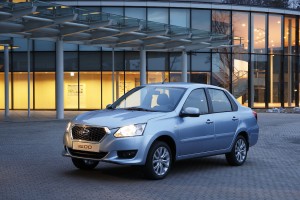
The Datsun on-DO is the brand's first offering in Russia. It is a four-door, five-seat family sedan.
Despite the air of perpetual crisis that hangs over the country, Russia is too simply too large and too important a market for carmakers to ignore, experts said during a conference on “Understanding Russia’s Current and Future Automotive Industry” at the University of Michigan.
“The Russian market is going to be larger than Germany,” said John Branch, a professor at the University of Michigan Ross School of Business told a conference sponsored by U-M’s Transportation Research Institute this week.
Automakers, particularly those with global ambitions, simply can’t afford to ignore the Russian market despite its volatile nature, added Branch, who noted the structure of the Russian auto industry is in flux as the demand for imports increases despite barriers imposed by the Russian government.
Lada, which is built by AutoVaz in which General Motors has invested, remains Russia’s most popular automotive brand. But the Lada brand is a holdover from the Soviet era and sales of Ladas are mostly concentrated in “third and fourth tier cities and rural” areas, Branch noted.
Russian consumers in major cities such as Moscow and St. Petersburg are becoming more brand conscious, like imported vehicles and have developed a preference for small sport utility vehicles that can navigate the country’s rugged roads and streets.
Daniel Russell, president of the U.S.-Russia Business council and a former American diplomat, said even with the current Ukrainian crisis, Russia is simply too important a country for the U.S. to ignore and U.S.-Russian relations could actually benefit from strong commercial ties. Russia is now involved in the negotiations aimed at keeping North Korea in check and in talks with Iran.
“There has been a dramatic jump in the Russian economy in the last 10 years,” he said, adding it’s doubtful other countries are willing to forego business with Russia.
Russia survived the threat of sanctions in 2008 after a brief war with neighboring Georgia, he said.
The Japanese government, for example, issued a statement condemning Russian action in Crimea. But then turned around and hosted some 200 Russian business executives the very same day, Russell noted. “Sanctions don’t work,” he said.
Russian car sales dropped by 50% in 2009 in the wake of global crisis but grew briskly for three years starting in 2010, reaching nearly 3 million units in 2012 before dropping by 5.5% in 2013. Another decline in Russian car sales is expected this year, experts said.
(Infiniti brings luxury to new level with QX80 Limited. For more, Click Here.)
But Nissan’s new Datsun brand recently opened for business in Russia and Fiat Chrysler Automobiles is pushing ahead with a venture to build Jeeps in Russia.
(Click Here to get details of Audi’s World Car of the Year victory.)
David Teolis, an economist with the General Motors Co., cautioned that predictions about the growth of the Russian market that have been routinely issued need to be examined. The slow growth of the Russian economy and Russian middle class since 2008 is hindering the expansion of the automotive market, he said, adding the chronic air of crisis that surrounds the country also has hurt Russia’s economic development.
(To see VW’s New Midsize Coupe concept coming to Beijing, Click Here.)
“Russia needs to become a normal country,” Teolis said. “The consensus long-term growth of gross domestic product has been downgraded by $500 billion.”
The downgrade in GDP per capita raises questions about Russia ability to sustain more growth in the automotive market in the future, he said.
